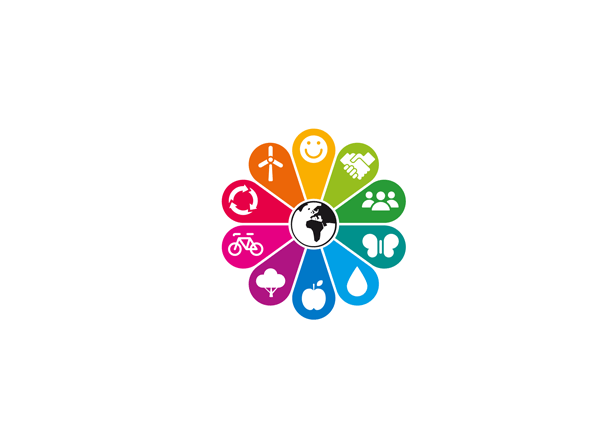Smart waste containers send a message to the collection vehicle when they are ready for emptying. Biowaste nutrients are recycled for use in local gardening and home farming activities. Rainwater is recovered for irrigation purposes or washing the car. New residents are welcomed with free public transport tickets. Instead of for vehicle traffic and parking, space is used for bicycles and light traffic routes. Bicycle corridors are built to enable rapid commuting. Intelligent street light systems, solar and green roofs, and a unique culture.
All these measures are being adopted as ways of building a sustainable lifestyle in urban residential areas of Jyväskylä and Vantaa.
In 2014, Sitra supported the implementation of the One Planet Living (OPL) approach in the transformation of the former mill area of Kangas in Jyväskylä into a lively urban district, and the construction of a new urban centre in the Kivistö area in Vantaa. The One Planet Living framework was used to draw up an action plan for both projects. This action plans serves as guidance on how to apply the ten principles of One Planet Living in the planning and construction phase as well as after the project has been completed. The effectiveness of the action plans was assessed on the basis of the ecological footprint of the area.
Sustainability was the starting point when planning both these urban areas. In Kivistö, the action plan was included in the zoning documentation. Applying the One Planet Living approach in the development has helped form an overall picture and embed sustainability into the planning process.
Ambitious goals have been set for both projects’ actions plans. In Kangas, 90% of the energy used in the area will be renewable by 2021, while in Kivistö, CO2 emissions will be reduced to the minimum by 2030. In Kangas, the future modal share of cycling or walking will be 47%. The aim is to achieve a reduction of 33% in water consumption through proper planning. In accordance with the principles of One Planet Living, the areas will also be made socially and economically sustainable. The residential building stock will be versatile and special needs will also be taken into account. In the Kangas area, the aim is to create more than 2,100 new jobs by 2025.
Achieving the sustainable development goals will require co-operation and commitment from all the parties concerned. In urban development projects, these parties include designers, architects, builders, developers, existing and new residents, associations and businesses. The ten principles of One Planet Living have been created to make all this easier.
“Clear principles create a mutual understanding of what sustainable development is, creating a common mindset,” says the project manager for the development project in Kangas, Tanja Oksa. The principles serve as guidelines on how to take all the dimensions of sustainability comprehensively into account in the planning process.
Above all, OPL is an effective tool for communication. “Among other benefits, the One Planet Living approach has increased and strengthened our internal network for sustainable development. People have recognised their interests and what they do in the principles. We have 45 people working on an action plan,” says Anna-Riitta Kujala, City Planning Technician at the City of Vantaa. Tanja Oksa agrees: “OPL is now a permanent part of our communications system. It is an excellent tool.”
Ecological footprinting is used to measure the achievement of the goals of the One Planet action plan. An ecological footprint indicates how well the way of life in a certain area fits within the limits of the Earth’s carrying capacity. It is estimated that Kivistö and Kangas achieve an ecological footprint of approximately 3.8 global hectares (gha) per capita through their action plans. This is equivalent to consuming the resources of 2.1 planets. The target for OPL communities is 3.4 gha, while the normal level is defined as 5.7 gha.
But the work is not finished yet. The One Planet action plans will naturally be updated as the projects progress. “Now we are focusing on how to implement the action plans in practice. The commitment of city residents will be a key factor of success. Our next step is therefore to encourage city residents to adopt the One Planet Living mindset,” says Anna-Riitta Kujala. The citizen engagement activities launched in the Kangas area in 2010 will also continue.
The project areas can apply for One Planet Living community certification. This option will be discussed by the development teams. “We tried the concept out in the development of the new urban centre in Kivistö first and, if the results are positive, we will apply it to the Kivistö area as a whole, and maybe even the whole city [of Vantaa],” says Anna-Riitta Kujala.
“Urbanisation and the desire to maximise the well-being of the residents is motivating us to try out new methods in urban development,” says Project Engineer Camilla Eklund from Skanska. In the opinion of Anna-Riitta Kujala and Tanja Oksa, who were involved in the practical testing of the One Planet Living concept, there is definitely a demand for the concept’s holistic approach in Finland.
“One Planet Living provides a comprehensive framework for sustainable urban development which, if applied correctly, will facilitate co-operation between project development partners and stakeholders and increase our understanding of what sustainable development is,” says Camilla Eklund.
The principles of One Planet Living:

Read more (in Finnish)
One Planet action plan for Kivistö
One Planet Living in Jyväskylä
One Planet Living in Finland (presentation by Antti Tuomainen, Skanska)
Ecological footprinting – a summary (Slideshare)



Recommended